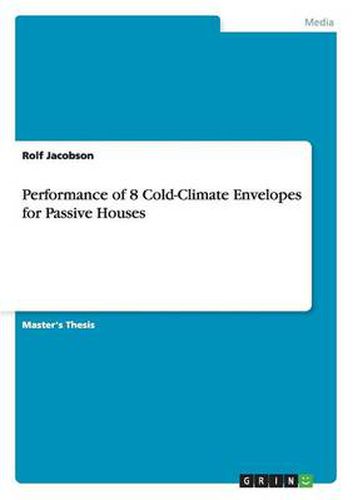Readings Newsletter
Become a Readings Member to make your shopping experience even easier.
Sign in or sign up for free!
You’re not far away from qualifying for FREE standard shipping within Australia
You’ve qualified for FREE standard shipping within Australia
The cart is loading…






Master’s Thesis from the year 2011 in the subject Art - Architecture / History of Construction, grade: none, University of Minnesota - Twin Cities (College of Design), language: English, abstract: Exterior envelopes for Passive Houses in very cold climates have not been developed, tested, and used as extensively as those in more mild climates such as central Europe. The purpose of this investigation was to push that development further by testing and comparing the performance of a variety of North American and Scandinavian envelope types that have been used in limited numbers for Passive Houses in those regions. A group of eight envelopes were selected and tested with a number of software analyses: Athena life cycle analysis, WUFI hygrothermal modeling, and THERM and EN ISO 6946 2-D U-value calculations for thermal bridging. Finally, the Passive House Planning Package (PHPP) was used to confirm that the envelopes met Passive House energy performance requirements in a very cold climate using a basic passive solar house design. Although significant variation was found in the performance of these eight envelope types, almost all of them were found capable of meeting the energy efficiency and thermal bridging requirements of the Passive House certification in a very cold climate, while maintaining moisture safety, durability, and significant life-cycle energy and carbon savings. These findings demonstrate that even in cold climates, a variety of envelope types can be used successfully for certified Passive Houses. Envelope types: 1) Advanced 2x6 framing24 on center with interior cross strapping and exterior insulation, insulated with mineral wool, 2) Advanced 2x6 framing24 on center, insulated with high-density spray polyurethane foam and exterior rigid foam, 3) Double 2x4 stud wall with studs 16 on center, insulated with blown cellulose, 4) I-joist (TJI) balloon framing 24 on center, insulated with blown fiberglass, 5) Insulated concrete form wall (ICF), usi
$9.00 standard shipping within Australia
FREE standard shipping within Australia for orders over $100.00
Express & International shipping calculated at checkout
Master’s Thesis from the year 2011 in the subject Art - Architecture / History of Construction, grade: none, University of Minnesota - Twin Cities (College of Design), language: English, abstract: Exterior envelopes for Passive Houses in very cold climates have not been developed, tested, and used as extensively as those in more mild climates such as central Europe. The purpose of this investigation was to push that development further by testing and comparing the performance of a variety of North American and Scandinavian envelope types that have been used in limited numbers for Passive Houses in those regions. A group of eight envelopes were selected and tested with a number of software analyses: Athena life cycle analysis, WUFI hygrothermal modeling, and THERM and EN ISO 6946 2-D U-value calculations for thermal bridging. Finally, the Passive House Planning Package (PHPP) was used to confirm that the envelopes met Passive House energy performance requirements in a very cold climate using a basic passive solar house design. Although significant variation was found in the performance of these eight envelope types, almost all of them were found capable of meeting the energy efficiency and thermal bridging requirements of the Passive House certification in a very cold climate, while maintaining moisture safety, durability, and significant life-cycle energy and carbon savings. These findings demonstrate that even in cold climates, a variety of envelope types can be used successfully for certified Passive Houses. Envelope types: 1) Advanced 2x6 framing24 on center with interior cross strapping and exterior insulation, insulated with mineral wool, 2) Advanced 2x6 framing24 on center, insulated with high-density spray polyurethane foam and exterior rigid foam, 3) Double 2x4 stud wall with studs 16 on center, insulated with blown cellulose, 4) I-joist (TJI) balloon framing 24 on center, insulated with blown fiberglass, 5) Insulated concrete form wall (ICF), usi